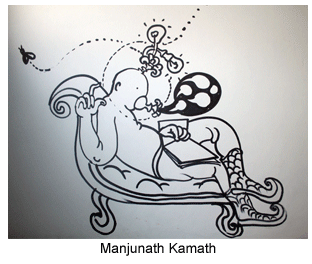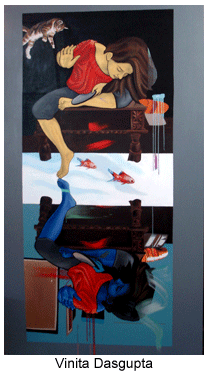- Prelude
- Hard Talk
- New Media
- Rolex : An Overview
- The age of Revivals: Neoclassical Furniture
- Democratization of the Medium No-Budget film: the Indian Context (!)
- Old Sound New Sound
- Decan Odyssey
- North East Opsis
- Russian cool breeze in hot Paris
- Around Kolkata
- Musings from Chennai
- In and around Santiniketan
- In between – from Vadodra
- A Tryst with Art in Madhya Pradesh
- Through the Looking Glass
- The Foreign Connection
- Market Insight
- Market Report
- Artist Index and Statistics
- Auction Reports
- The month that was
- Delhi Dias
- Art Bengaluru
- Mumbai Art Sighting
- Creative Impulse
- Subodh Gupta
- Pooja Iranna
- Preview
- In the News
ART news & views
Delhi Dias
Volume: 2 Issue No: 9 Month: 10 Year: 2010
The medium bares the artist
Choosing a medium or a mixture of mediums that best fit the demands of the subject is as important as the choice of palette. -Tom Huntley Art is an interaction between the artist and his medium, individual experiences with the cultural matrix, and artwork with its audience. The evolution of art over the years can be identified with the artists' increasing need to explore every facet of it. From cave art to photography to sound and video installations, each medium, with the passing of time has seen mass appeal, only to be later contested for its limitations in creating an experience for the viewers.
In recent years, the emergence of new media has opened unforeseen avenues of creating experiences which transcend dimensions and come to the aid of any artist seeking to connect with the viewer on an ephemeral plane of complete understanding that leaves a lingering impression on their psyches. Some art makers employ traditional mediums in radical ways to create the feeling of novelty which manages to negate the feeling of the art work being “done” before.
The Delhi art-scape has recently been exposed to artists and exhibitions that have taken certain conventional art practices to a new level. Though the media employed may not be revolutionary, their manifestations in the art works commanded the viewers' attention and induced audience response.  These artists have been applauded widely for their attempts at breaking the presumptions made of how art works should be and going ahead with their instincts, as is evident in their work.
These artists have been applauded widely for their attempts at breaking the presumptions made of how art works should be and going ahead with their instincts, as is evident in their work.
'Each Night Put Kashmir in Your Dreams' by NilimaSheikh, was a travelling from Chemould Art Gallery to Lalit Kala Academy. The show is more than a collection of artworks inspired, like so many others, from Kashmir, its beauty and the state of distress it's in; it is the result of six years of hard work and a lifetime of love felt for the land and its people. Borrowing the title from Agha Shahid Ali's poetry, which she feels best expresses the connection she shares with Kashmir, Nilima Sheikh has created works that portray the state as the paradise it was once famed to be. Drawing from historical narratives from across spaces and time, the artist blended them to create 9 scroll-like canvases (sized 10 by 6 feet), each more delicate and exquisite than the other, a complex pattern of colors and textures. The visual language is a pastiche of artistic techniques, their sources ranging from Sheikh's own light, miniature style to Thangka art from Buddhist silk paintings (which have roots in Kashmir), planned on a large format.
The scenes depicted on the art works suspended from the ceiling made a bold statement on the contrast between the rich multicultural heritage of the land of Kashmir and its present, almost war-torn state. Behind these intricate images depicting the plight of long lost heaven, were extracts from the sayings of LalDed, the 14th century Hindu saint-poetess from Kashmir, references from Kalhan, the ancient historian native to Kashmir, prose from Salman Rushdie's novel 'Shalimar the Clown,' the works of ChitralekhaZutshi, the historian and Aga Shahid Ali's poetry. Though seeming too much to read at one go on the first sight, the text painted (and not printed) behind the canvas is chosen and represented so beautifully that one is forced to acknowledge how it completes the entire experience Nilima wanted to create. The soft hues of pink, gold and a dream-like pallet of colors creates a space of quiet absorption of the beauty of Kashmir, it's stories and its sadness, and contemplation of its silent decadence.
Manjunath Kamath's 'Conscious-Sub-Conscious' was not so much a medimatic experiment as it was a spatial one. Using the gallery as his studio for a week, drawing on the walls, the floors and the ceiling, a series of spontaneous drawings in black and white, the artist went on to create an astonishing masterpiece at Gallery Espace that, without any intent to do so on his part, left those harping on the commercialization of art speechless...for an evening atleast. Thwarting questions from critics, journalists and viewers that kept pouring in, constantly asking him what he planned to make next, the artist gleefully replied “I don't know what I am going to do on the gallery walls.” The joy that Manju derives from the practice of spontaneous drawing was apparent on his face throughout the realization of the project. Explaining that this wasn't intended to be a statement of any sort against any belief, the artist wanted to just return to the aspect of art which makes it uninhabited and pleasure-giving. Seeking to emphasize that performance-art is not subservient to props, costumes or theatrics, he attempted to practice the same in a white cube (read gallery).  In a conversation, sometime ago, Kamath had mentioned how he loves to give away little drawings with his signature at the bottom, completely making the concept of “artist's original signed copy” redundant.
In a conversation, sometime ago, Kamath had mentioned how he loves to give away little drawings with his signature at the bottom, completely making the concept of “artist's original signed copy” redundant.
When asked what the drawings signified, the first few hundred times he simply replied that they were the outcome of the connection between his brain and his fingers, not adhering to an idea but to the act of drawing whatever he felt like, before eventually stopping from giving any reply whatsoever.
The drawings themselves carried the wit so effortless in the man who made them. With very interesting cartoon-like figures that Manju can draw endlessly, he created individual artworks, separated by the architecture of the gallery itself. What was notable in these artworks was the manner in which he incorporated little elements of the gallery structure like the switch boards and pillars into the drawings, weaving them into his imaginary canvas in order to create a play of visuals that were a delight to observe. The audience, ranging from children to many noted names from the industry, had collective smile on their faces on the open day as they excitedly pointed out things that they had probably not noticed in one go. The knowledge that the walls would be soon painted over, forever covering the art works made the show feel ephemeral and made those attending feel like they were witnessing a moment out of time. Walking through the exhibition was like walking through theartist's imagination itself.
In the midst of such large scale grandeur, quietly in her studio, Vinita Dasgupta keeps working on her intimate series, 'My Window Shut To Open'. “Meaning is meant to be slippery and non-linear, allowing the viewer to enter and create their own narrative” says Vinita Dasgupta, even as her works echo her thoughts. A series of paintings, recreating photographs on canvas, 'My Window Shut To Open' is a riot of colors and emotions that are a part of the person that the artist is. The art works are like pieces of her state of mind, a distracted, half conscious state that causes jumble of unrelated things: scraps of memory, floating impressions, thoughts and feelings that float in a disorganized mix. The final works are like peep holes into Vinita's life which she hopes that the viewers can look through and experience for a fleeting moment what she stands for. The process is like catharsis for her and the paintings intentionally narcissistic, thereby turning the act of creating them into a sort of spiritual self-exploration that is essential for her growth as an artist and a human being.